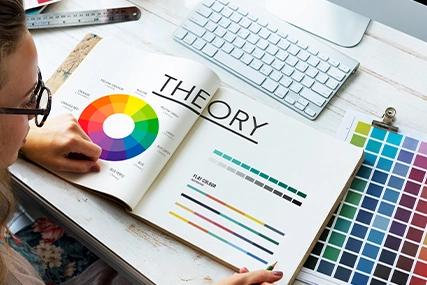
CHOOSING THE RIGHT PALETTE FOR YOUR BRAND
In today’s digital era, your website frequently serves as the very first interaction potential customers have with your brand. As someone who does designs, I understand how crucial it is to create a lasting impression. The colors you choose for your website play a pivotal role in shaping perceptions, evoking emotions, and guiding user behavior. Colors have an incredible ability to influence how visitors perceive your brand. This is where understanding color psychology becomes essential. For example, blues often inspire trust and professionalism, which is why many successful companies rely on them. Reds can stimulate excitement and urgency, perfect for calls to action. By carefully selecting a palette based on these insights, your website can better resonate with your target audience and reinforce your brand identity.
If you are looking for a web design company in Kochi, it's important
to partner with professionals who grasp the power of color and design psychology. A
well-crafted color scheme not only enhances visual appeal but also drives user engagement
by making navigation intuitive and calls-to-action clear. This strategic approach results
in improved conversions and a stronger online presence.
Moreover, cultural nuances matter, a color that appeals to one demographic might not work
for another. This consideration is especially important for businesses in diverse regions
like Kochi, where audiences may have varied cultural backgrounds. A web design company in
Kochi experienced in local trends can tailor your website’s colors to suit your audience
perfectly.
Ultimately, as someone who does designs, I know that colors are more than just decorative
elements, they are strategic tools. When harnessed properly, they can build trust, evoke
the right emotions, and encourage visitors to take meaningful actions, turning your website
into a powerful business asset.
Understanding the Basics of Color Psychology
Color psychology is the study of how different colors influence human emotions, perceptions, and behaviors. In the context of web design, it plays a crucial role in shaping how visitors feel about your brand and how they interact with your website. Each color carries its own unique set of meanings and can evoke specific emotional responses, which designers strategically use to guide user experience and behavior.
Blue builds trust and calmness, often used by tech and healthcare brands.
Blue builds trust and calmness, often used by tech and healthcare brands.
Green symbolizes growth and health, perfect for eco-friendly and wellness sites
Yellow radiates optimism but should be used sparingly.
Purple conveys luxury and creativity, often favored by beauty and premium brands.
Understanding these basics helps you align your brand’s message with your website’s color scheme.
How to Choose the Right Palette for Your Brand
Selecting a color palette for your website is a delicate art that goes beyond simply choosing colors you like. It requires balancing emotional impact, how colors make your visitors feel, with usability, how easily they can navigate and interact with your site. Both elements are essential to create an engaging, effective online presence that serves your brand and your users well.
Your target audience’s preferences and cultural meanings of colors.
Harmonious combinations using color theory: monochromatic, analogous, or complementary schemes.
Neutral tones (black, white, gray) to balance and highlight key elements.
Accessibility to ensure readability for all users.
Color in Action: Web Design Examples
Great web design goes far beyond aesthetics, it uses color as a powerful strategic tool to enhance user experience, reinforce brand identity, and drive desired actions. Every color choice on a website is intentional and serves a specific purpose, making the design not only visually appealing but also highly functional.
Corporate sites often use blue to inspire confidence.
E-commerce platforms highlight red or orange for urgency on buy buttons.
Environmental blogs incorporate greens and earth tones for authenticity.
Luxury brands employ deep purples and gold accents for elegance.
Tools to Help You Pick the Perfect Colors
Refining your color palette is a crucial step in creating a visually harmonious and effective website. The right tools can simplify this process, helping you select colors that complement each other, maintain accessibility, and align perfectly with your brand’s identity and goals. Here are some highly useful tools and techniques to help you fine-tune your palette:







